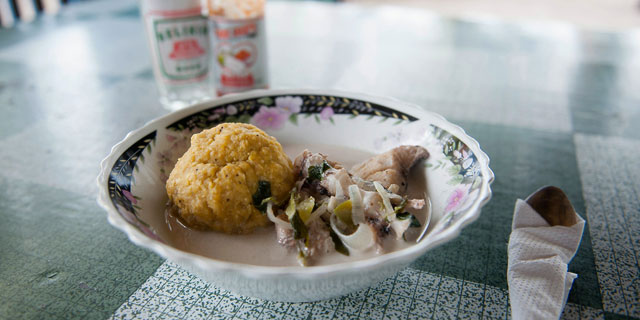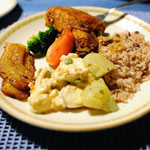Stretching along the Caribbean coast, directly below Mexico, Belize is no longer a well-kept secret as a travel destination, recognized for its romantic offshore cayes, adventure-filled rainforests, and Maya temples. Yet its diverse and rich culinary landscape remains little known outside its borders. Not anymore. Here's your foodie introduction to Belize.
"Belize and her cuisine are unique because she has dual citizenship: Central American and Caribbean," said Chef Sean Kuylen, one of Belize's celebrated chefs, trained in San Francisco and with a career that spans several Caribbean resorts.
This duality in Belize's identity, Latin and Afro-Caribbean, is hard to miss when you're traveling around the country. Up to eight major ethnic groups coexist across six districts, in a country of just about 320,000 inhabitants: from descendants of the ancient Maya, the first to inhabit Belize, to Spanish-descended Mestizos and two Afro-Caribbean groups (the Creole and Garinagu). And then there are communities of East Indians, Mennonites, Chinese, and Lebanese.
Naturally, this diversity, in large part the result of colonialism, as well as escape from war and persecution, spills into every aspect of life. You'll see it year round in music, festivals and costumes; hear it in local languages; and taste it in the food.
In the western Cayo District, which borders Guatemala, and up north, Latin flavors and Mexican-influenced heritage dominate. From morning to the wee hours of night, street carts dish out cheap, steaming hot tacos or garnaches (crispy, fried tortilla shells topped with refried beans, cabbage and cheese) while restaurant daily specials list tamales and escabeche. This Spanish influence dates back to 1847, when the Caste War led thousands of Mexicans, Mestizos, and Mayans to seek refuge across the border and into Belize's northern districts.
Along the picturesque south coast, an Afro-Caribbean culture thrives in the Stann Creek District, home to Garífuna beach villages and towns. There, you'll spot women mashing green bananas with a mortar and pestle and serving cassava, freshly caught fish and coconut stews, staples of this seafaring, Afro-Amerindian people. The Garinagu people brought their West African and Carib Indian heritage along on a tortuous journey that led them from Nigeria to St. Vincent, where they escaped and lived free before the British arrived and exiled them to Roatán. From there, they migrated along the coast of Central America, reaching Belize in 1802. Today, their foods are among the most unique in the country.
Next, a look at two classic dishes of Belize… [pagebreak]
There are two classic dishes any traveler to Belize should know:
Hudut
Pronounced "hoodoot", this is the star Garífuna specialty, served at least once a week in the south. Short for hudutu baruru sere lasus, it consists of fish simmered in a rich coconut broth spiced with okra and thyme (this broth is called sere lasus) and served with a side plate of mashed green plantains (called hudutu or hudut). Grab a small lump of the mashed plantain with your fingers (or a spoon, if you must), dip it in the coconut sauce while also taking a slice of the snapper and let it all melt in your mouth. The coconut flavor isn't overwhelming because the mashed plantains help absorb the broth's flavor.
Stew Chicken
In spite of this incredible variety of dishes and ethnicities across the country, most Belizeans agree: a plate of stew chicken, a deliciously spiced reddish-brown stew served with a side of coconut rice and beans, a couple of fried plantain slices, and homemade potato salad is their country's national dish.
The Creole specialty is the most common find in the country. The Creole are descendants of the mix between the British who came to harvest woods and enslaved West Africans brought to Belize in the 18th century, by way of Jamaica. The tastiest stew chicken you'll find is in Belize City and Belize District's local restaurants, an area considered the heart of this culture, but there are equally decent versions of the fragrant stew in even the most remote areas of Belize.
Next, we're heading into the kitchen… [pagebreak]
If you're lucky, as I was a few years ago while staying with the Heusner family at Belize River Lodge, you'll find yourself enjoying stew chicken at a Belizan's home on a Sunday, when most gather at the dinner table to enjoy this national meal.
Stew chicken has hints of Jamaican and British influence, the coconut rice and beans are indeed similar to Jamaica's rice and peas, though this remains speculative, and the English brought their potato salad. But an even closer look at this unofficial national dish reveals that it actually represents the mosaic of cultures that is Belize.
"Belize's stew chicken uses Creole, and Maya and Mestizo cooking techniques and ingredients," explained Kuylen. "The recado paste, used in cooking the stew to give it that deep amber color, is made of annatto and corn masa, which are staple ingredients of the Maya and Mestizo cultures. Therefore, it's an interesting combination of Belize's cultures and flavors."
For Belize's culinary experts, like Kuylen or Chef Jenny Staines (owner of the popular Elvi's Kitchen) this multiculturalism presents an exciting playground for creativity, in a young country and a culinary scene that's constantly evolving.
"The Maya, Garífuna, Creole and Mestizo have cooked with highly complex methods for years," explained Kuylen. "I see myself as a matchmaker, fusing our local ingredients and cultures, which were there all along. The creations are endless and our food can be showcased among the world’s finest as our rainforest is naturally organic and our barrier reef is very much alive and healthy. In my opinion, Belize has always had a cuisine, we were just a bit timid in showcasing her."
There's no better way to begin your journey of Belize's fascinating culinary heritage than by trying out Kuylen's recipes for stew chicken and hudut.
Coconut Seafood Soup (Hudut Baruru with Sere Lasus)
- 4 large green plantains, peeled
- 2 large ripe plantains, peeled
- 2 cups fresh coconut milk
- 1 cup sliced onion
- 4 cloves garlic, minced
- 2 whole habanero peppers, deseeded
- 1 bunch fresh basil
- salt and freshly ground black pepper, to taste
- 4 medium snapper filets
- 1 large chicken, cut into serving pieces
- 3 tablespoon red recado paste (annatto)
- 1 cup water
- 1 tablespoon coconut oil
- 2 tablespoons brown sugar
- 2 large onions, diced
- 1 large bell pepper, deseeded and diced
- 3 cloves garlic, minced
- black pepper and salt, to taste



![Making Mealtime Matter with La Familia: Easy Sofrito [Video]](https://thelatinkitchen.com/wp-content/uploads/2015/10/sofrito-shutterstock__0-500x383.jpg)
![Easy Latin Smoothies: Goji Berry Smoothie [Video]](https://thelatinkitchen.com/wp-content/uploads/2015/12/goji_berry-shutterstock_-500x383.jpg)
















![Fun and Fast Recipes: Fiesta Cabbage Salad [Video]](https://thelatinkitchen.com/wp-content/uploads/2015/11/fiesta_cabbage_slaw-shutterstock_-500x383.jpg)









